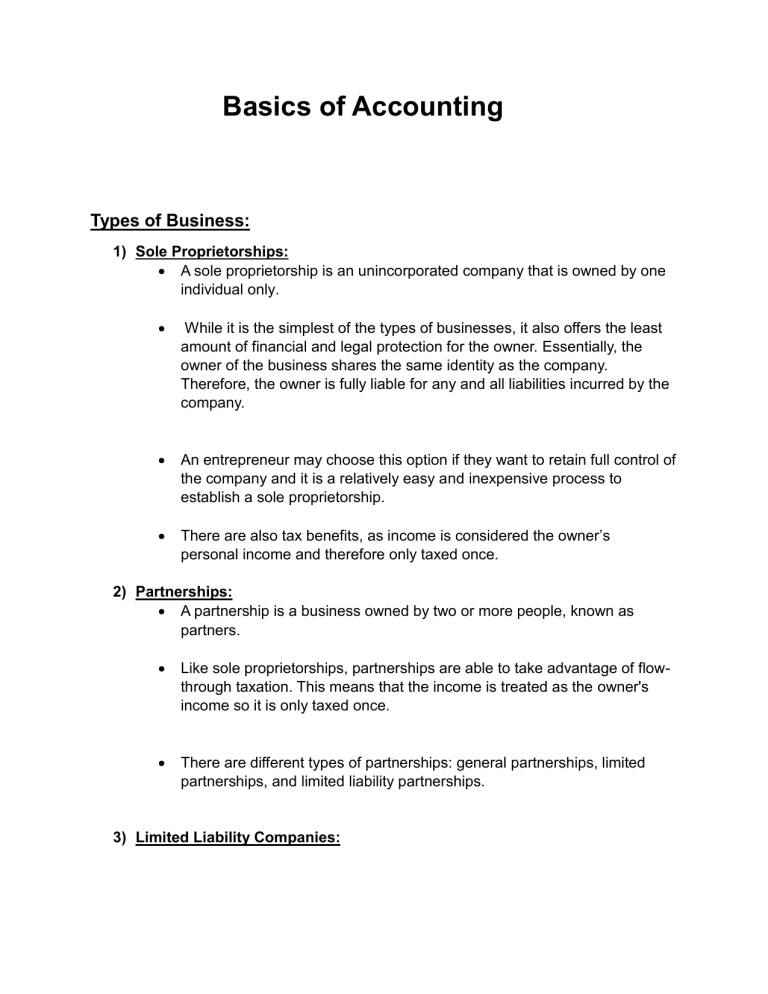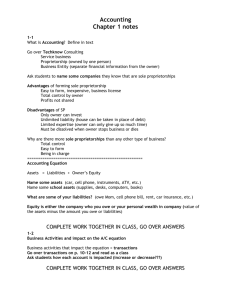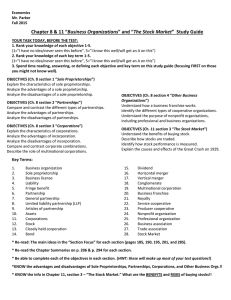Basics of Accounting: Business Types & Accounting Principles
advertisement

Basics of Accounting Types of Business: 1) Sole Proprietorships: A sole proprietorship is an unincorporated company that is owned by one individual only. While it is the simplest of the types of businesses, it also offers the least amount of financial and legal protection for the owner. Essentially, the owner of the business shares the same identity as the company. Therefore, the owner is fully liable for any and all liabilities incurred by the company. An entrepreneur may choose this option if they want to retain full control of the company and it is a relatively easy and inexpensive process to establish a sole proprietorship. There are also tax benefits, as income is considered the owner’s personal income and therefore only taxed once. 2) Partnerships: A partnership is a business owned by two or more people, known as partners. Like sole proprietorships, partnerships are able to take advantage of flowthrough taxation. This means that the income is treated as the owner's income so it is only taxed once. There are different types of partnerships: general partnerships, limited partnerships, and limited liability partnerships. 3) Limited Liability Companies: LLCs are formed on the principle of separate legal entity which basically means that the business protects owners from being personally liable for the company’s debts or legal disputes. A LLC is more complicated and expensive to create, as compared to the other three types of businesses. Articles of incorporation must be drafted, which include information such as the number of shares to be issued, the name and location of the business, and the purpose of the business. In sole proprietorships and partnerships, if one of the owners passes away or declares bankruptcy, the company is dissolved. Corporations exist as legally separate entities. Therefore, they are protected from this situation and will continue to exist even if the owner of the business passes away. There are two main types of LLCs: 1) Public Limited Companies: A public limited company (PLC) is an organization that is legally allowed to offer its shares for sale to the public. A plc is owned by shareholders, and managed by directors. Members of the public can purchase stock, and most pay out dividends once or twice a year. 2) Private Limited Companies: A private limited company (Ltd) does not publically trade shares and is limited to a maximum of fifty shareholders. Definition of Accounting: It is a process of recording financial transactions pertaining to the business. The process includes summarizing, analyzing, and reporting these transactions to the users of the company. Types of Accounting: 1) Financial Accounting: This type of accounting refers to the processes used to generate interim and annual financial statements to report their financial position and performance to people outside the company including investors, creditors, suppliers, and customers. 2) Managerial Accounting: Managerial accounting uses much of the same data as financial accounting, but it organizes and utilizes information in different ways. In this type of accounting an accountant generates monthly or quarterly reports that a business's management team can use to make decisions about how the business operates. 3) Cost Accounting: Cost accounting is a type of managerial accounting that focuses on the cost structure of a business. It assigns costs to products, services, processes, projects, and related activities. Through cost accounting, you can hone in on where your business is spending its money, how much it earns, and where you might be losing money. Managers and employees may use cost accounting internally to improve your business’s profitability and efficiency. 4) Tax Accounting: Tax accounting is the subsector of accounting that refers to the methods and policies used for the preparation of tax returns and tax payments. Tax accounting is a set of methods for accounting and a useful tool that companies use to understand their tax liability and avoid penalties. Double Entry Accounting System: Double-entry bookkeeping is a method of recording transactions where for every business transaction, an entry is recorded in at least two accounts as a debit or credit. In a double-entry system, the amounts recorded as debits must be equal to the amounts recorded as credits. You should always remember that each side of the equation must balance out. This is how we arrive at the term “balancing the books.” The double-entry bookkeeping system works on the basic accounting equation, as follows: Assets = Liabilities + Equities There are five basic components of double entry accounting system: Assets: The money that the company owns Liabilities: Anything that the business owes Owner’s equity: Owner’s investment in the company Income: Money the business earns by selling its products Expense: Money the company spends to run the business Accounting Cycle: Financial accountants typically operate in a cyclical environment with the same steps happening in order and repeating every reporting period. These steps are often referred to as the accounting cycle, the process of taking raw transaction information, entering it into an accounting system, and running relevant and accurate financial reports. The steps of the accounting cycle are: Step#1: Collect transaction information such as invoices, bank statements, receipts, payment requests, uncashed checks, credit card statements, or other mediums that may contain business transactions. Step#2: Post journal entries to the general ledger for the items in Step 1, reconciling to external documents whenever possible. Step#3: Prepare an unadjusted trial balance to ensure all debits and credits balance and material general ledger accounts look correct. Step#4: Post adjusting journal entries at the end of the period to reflect any changes to be made to the trial balance run in Step 3. Step#5: Prepare the adjusted trial balance to ensure these financial balances are materially correct and reasonable. Step#6 Prepare the financial statements to summarize all transactions for a given reporting period. Basis of Accounting: The basis of accounting describes how financial activities are recognized and reported; specifically, when revenues, expenditures (or expenses), assets, and liabilities are recognized and reported in the financial statements. The two bases of accounting include the following: 1) Cash method of Accounting: Cash basis refers to the basis that recognizes revenues and expenses at the time cash is received or paid out. 2) Accrual method of Accounting: The accrual basis of accounting contrasts the cash basis, where income is recognized at the time the revenue is earned and expenses are recognized when liabilities are incurred regardless of when cash is received or paid. Importance of Accounting Function: Accounting is a back-office function where employees may not directly interface with customers, product developers, or manufacturing. However, accounting plays a key role in the strategic planning, decision-making, and growth of the company, fundraising of the company, operational management, and compliance requirements of a company .






